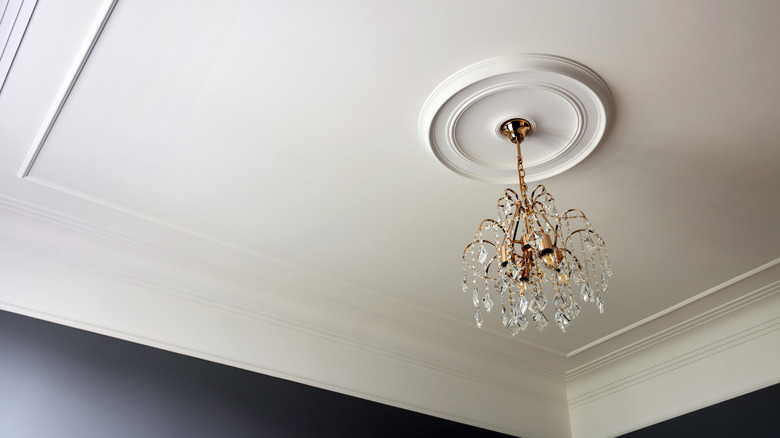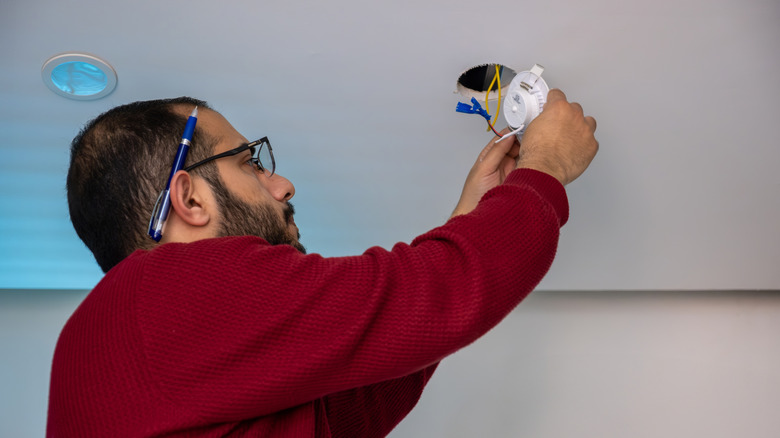Head To The Thrift Store For Lamps, But Here's Why To Avoid Chandeliers And Hanging Light Fixtures There
The thrift store is like a treasure hunt for adults. You never know when you'll stumble upon a one-of-a-kind piece that fits perfectly into your home decor. That includes unique vintage lighting options. According to many designers, lamps are a decor item you should always check the thrift store for first. But what about hardwired light fixtures like chandeliers? Proceed with caution if you're looking for an overhead light at a secondhand store. Thrifted vintage light fixtures often have outdated wiring that comes with a high risk of electrical shocks and fires, and they could contain dangerous materials.
Residential wiring has evolved significantly over the years. Early home wiring was often inconsistent until standardized wiring practices became more prevalent in the early 20th century. Modern-day wiring incorporates more safety features like grounding methods, circuit breakers, and GFCI outlets. Older electrical work might also contain dangerous materials like asbestos and lead. With research and experience, experts learn what works well and what is dangerous when it comes to electrical components, which allows them to offer safer alternatives. The wiring in light fixtures has also improved as experts learn more about electrical components.
As you're chasing the thrill of thrifting the perfect light, knowing what to look for in the construction and wiring helps you make a safe purchase. Inspecting the wiring carefully and having fixtures inspected by an electrician can help you embrace vintage lighting trends safely. You also have the option to rewire older fixtures to bring them up to date without changing the appearance.
Vintage light fixtures might have dangerous, faulty wiring
Older wiring materials like cloth-insulated wires may be more flammable and less able to control heat than the materials used in new wiring, which could increase the risk of electrical fire. Age takes a toll on all types of wiring, often making it brittle and prone to breaking. An old fixture could have frayed or exposed wires that can cause arcing, shorts, shocks, and fires when you connect it to your home's electrical system. You may also run into the issue of old fixture wiring not meeting current electrical codes. That means you probably won't find an electrician who will install the fixture as-is. Some areas require testing by a UL-certified electrician before you can install a fixture, which makes profession installation trickier.
Another possible problem is buying an old light fixture with the wrong type of socket. This often happens with older fixtures that were manufactured in European countries, where the sockets are different than U.S. sockets. You'll need to have the socket changed to fit the light bulbs that are available locally.
You can have a vintage fixture professionally rewired — it's one of many electrical projects you shouldn't attempt at home. Always have thrifted light fixtures inspected by an electrician to ensure the wiring and socket are safe. The wiring may look intact despite its old age, but that doesn't mean it's safe for use in modern homes. It can be difficult to find UL-certified electricians to perform the work. Keep in mind that completely restoring and updating a fixture can be quite expensive, too.
Older fixtures may contain hazardous materials
Some vintage fixtures may also contain dangerous materials that you don't want in your home. For example, cloth wiring sometimes includes asbestos as a way to make it less flammable. Due to the age, the old cloth wiring often becomes brittle, which allows it to break and release the asbestos fibers. If you inhale those fibers during the installation or while you're restoring the light fixture, you could experience health issues.
Lead is another component that appears in vintage items, including some light fixtures. Older home items may contain lead paint, and light fixtures could contain solder with lead in it. The potentially dangerous material usually isn't an issue on items like lights that you're displaying. However, you could disturb the lead if you do any restoration or cleaning work on thrifted fixtures that you use to add vintage touches to your space. A restoration professional can help you identify the materials in the fixture and let you know if the materials are risky to your health.


